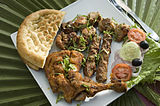Balti (food)/ja: Difference between revisions
Created page with "フードライターのパット・チャップマンによると、この言葉の起源はカシミール地方北部にあるバルティスタン地域に遡ることができるという。そこでは、中国の中華鍋に似た鋳鉄製の中華鍋が調理に使われている。バルティスタンは中国と国境を接している。彼の著書『:e..." Tags: Mobile edit Mobile web edit |
Created page with "しかし、コリーン・テイラー・センは、バルティスタンで食べられている料理は''バルティ・ゴシュト''とは「似ていない」ため、''バルティ・ゴシュト''の起源は不明確であると述べている。そのため、この料理の名前は、''バルティ・ゴシュト''がヒンドゥスターニー語でバケツを意味する''baltī''に似た鍋で調理されるという事実に..." Tags: Mobile edit Mobile web edit |
||
| Line 14: | Line 14: | ||
[[:en:Pat Chapman (food writer)|フードライターのパット・チャップマン]]によると、この言葉の起源は[[:en:Kashmir|カシミール地方]]北部にある[[:en:Baltistan|バルティスタン]]地域に遡ることができるという。そこでは、中国の[[Wok/ja|中華鍋]]に似た[[Cast-iron cookware/ja|鋳鉄製の中華鍋]]が調理に使われている。バルティスタンは中国と国境を接している。彼の著書『[[:en:Curry Club Magazine|カリークラブ・バルティカレー・クックブック]]』の中で、チャップマンは次のように述べている。{{quote|バルティ鍋は、丸底で中華鍋のような重い鋳鉄製の鍋で、2つの取っ手がついている。...バルティ料理の起源は多岐にわたり、([[Sichuan cuisine/ja|四川料理]]の辛い料理に少し似た)中国料理や[[Tibetan cuisine/ja|チベット料理]]だけでなく、[[:en:Mirpur, Azad Kashmir|ミールプール人]]の祖先、[[:en:Mughlai cuisine|ムガル皇帝]]の[[:en:Mughal emperors|嗜好]]、[[Kashmiri cuisine/ja|カシミール]]の香り高いスパイス、そして山岳地帯の「冬の食べ物」にも負うところが大きい。|author=|title=|source=}} | [[:en:Pat Chapman (food writer)|フードライターのパット・チャップマン]]によると、この言葉の起源は[[:en:Kashmir|カシミール地方]]北部にある[[:en:Baltistan|バルティスタン]]地域に遡ることができるという。そこでは、中国の[[Wok/ja|中華鍋]]に似た[[Cast-iron cookware/ja|鋳鉄製の中華鍋]]が調理に使われている。バルティスタンは中国と国境を接している。彼の著書『[[:en:Curry Club Magazine|カリークラブ・バルティカレー・クックブック]]』の中で、チャップマンは次のように述べている。{{quote|バルティ鍋は、丸底で中華鍋のような重い鋳鉄製の鍋で、2つの取っ手がついている。...バルティ料理の起源は多岐にわたり、([[Sichuan cuisine/ja|四川料理]]の辛い料理に少し似た)中国料理や[[Tibetan cuisine/ja|チベット料理]]だけでなく、[[:en:Mirpur, Azad Kashmir|ミールプール人]]の祖先、[[:en:Mughlai cuisine|ムガル皇帝]]の[[:en:Mughal emperors|嗜好]]、[[Kashmiri cuisine/ja|カシミール]]の香り高いスパイス、そして山岳地帯の「冬の食べ物」にも負うところが大きい。|author=|title=|source=}} | ||
しかし、[[:en:Colleen Taylor Sen|コリーン・テイラー・セン]]は、バルティスタンで食べられている料理は''バルティ・ゴシュト''とは「似ていない」ため、''バルティ・ゴシュト''の起源は不明確であると述べている。そのため、この料理の名前は、''バルティ・ゴシュト''がヒンドゥスターニー語でバケツを意味する''baltī''に似た鍋で調理されるという事実に由来する可能性がある。 | |||
<div lang="en" dir="ltr" class="mw-content-ltr"> | <div lang="en" dir="ltr" class="mw-content-ltr"> | ||
Revision as of 08:35, 13 July 2025

バルティまたはバルティ・ゴシュト(ウルドゥー語: بالٹی گوشت、ヒンディー語: बाल्टी गोश्त)は、「バルティボウル」と呼ばれる薄いプレス鋼製の中華鍋で提供されるカレーの一種である。この名前は、特定の材料や調理法に由来するのではなく、カレーを調理する金属製の器に由来している可能性がある。バルティカレーは、ギーではなく植物油を使い、炒め物のように強火で手早く調理され、骨なしの肉が使われる。この組み合わせは、一日中ゆっくり煮込む伝統的な一品料理のインドカレーとは大きく異なる。バルティソースは、ニンニクと玉ねぎをベースに、ターメリックやガラムマサラなどのスパイスが使われる。
バルティ・ゴシュトは北インドやパキスタンの一部、そしてイギリスなど世界各地で食べられている。イギリス版のバルティは1977年にバーミンガムで開発された。
起源、歴史、語源

食品としてのバルティは、同地域のカラヒと同様に、調理される鋼鉄または鉄製の鍋にちなんで名付けられている。 この言葉はヒンドゥスターニー語、オリヤー語、ベンガル語に見られ、「バケツ」を意味する。この言葉は、バケツまたは手桶を意味するポルトガル語のbaldeに由来し、16世紀初頭のポルトガル人の航海事業を通じてインド亜大陸にもたらされた。この言葉は、おそらくイギリス領インド帝国時代に英語に入ったものと思われる。
フードライターのパット・チャップマンによると、この言葉の起源はカシミール地方北部にあるバルティスタン地域に遡ることができるという。そこでは、中国の中華鍋に似た鋳鉄製の中華鍋が調理に使われている。バルティスタンは中国と国境を接している。彼の著書『カリークラブ・バルティカレー・クックブック』の中で、チャップマンは次のように述べている。
バルティ鍋は、丸底で中華鍋のような重い鋳鉄製の鍋で、2つの取っ手がついている。...バルティ料理の起源は多岐にわたり、(四川料理の辛い料理に少し似た)中国料理やチベット料理だけでなく、ミールプール人の祖先、ムガル皇帝の嗜好、カシミールの香り高いスパイス、そして山岳地帯の「冬の食べ物」にも負うところが大きい。
しかし、コリーン・テイラー・センは、バルティスタンで食べられている料理はバルティ・ゴシュトとは「似ていない」ため、バルティ・ゴシュトの起源は不明確であると述べている。そのため、この料理の名前は、バルティ・ゴシュトがヒンドゥスターニー語でバケツを意味するbaltīに似た鍋で調理されるという事実に由来する可能性がある。
Another claim regarding the origin of balti cooking in Birmingham was that it was first served in 1977 in a restaurant called Adil's. At that time, the restaurant was located in Stoney Lane, Sparkbrook, and after some time relocated to another area, but since has returned to its original place in Stoney Lane.
Balti houses


Balti restaurants are often known in Birmingham as 'balti houses'. Some balti houses have a plate of glass on the table top with menus secured beneath. Balti houses typically offer large karack naan bread pieces, to be shared by the whole table.
Balti houses were originally clustered along and behind the main road between Sparkhill and Moseley, to the south of Birmingham city centre. This area, comprising Ladypool Road, Stoney Lane, and Stratford Road, is still sometimes referred to as the Balti Triangle, and contains a high concentration of balti restaurants. On 28 July 2005, a tornado caused extensive damage to buildings in the triangle, forcing many restaurants to close. Most reopened by the beginning of 2006 but by 2023 only four remained.
Balti restaurants have now spread beyond the triangle, and can also be found in the south of Birmingham, along the Pershore Rd in Stirchley. Lye near Stourbridge to the west of Birmingham has become known as the 'Balti Mile' with up to a dozen restaurants clustered along the High Street.
The food and its style of presentation proved very popular during the 1980s, and popularity grew in the 1990s. Balti restaurants gradually opened up throughout the West Midlands, and then a large part of Britain. The expanded curry market in Britain is now said to take in 4 billion pounds sterling per year.
Outside Britain, a small number of balti houses are in Ireland and many other English-speaking countries, particularly Australia, Canada, and New Zealand.
Since the late 1990s, British supermarkets have stocked a growing range of prepacked balti meals, and the balti restaurant sector has since faced increasing competition from the retail sector and from changes in customer tastes, along with other traditional South Asian and Indian restaurants.
See also
参考資料
- 『カリークラブ・バルティカレー・クックブック』、ピアトカス、ロンドン — ISBN 0-7499-1214-6 & ISBN 0-7499-1342-8(1993年)
- 『モダン・バルティカレー』、上記をジョン・ブレイク・パブリッシングより再版、ロンドン(2006年)
- 『パット・チャップマンズ・バルティ・バイブル』、ホッダー&スタウトン、ロンドン — ISBN 0-340-72858-2 & ISBN 0-340-72859-0(1998年)
- 『2009年 コブラ グッド・カリー・ガイド』、ジョン・ブレイク・パブリッシング、ロンドン — ISBN 1-84454-311-0
外部リンク
| この記事は、クリエイティブ・コモンズ・表示・継承ライセンス3.0のもとで公表されたウィキペディアの項目Balti (food)(12 April 2025, at 20:21編集記事参照)を翻訳して二次利用しています。 |
